+44 75754 30035 help@rapidassignmenthelp.co.uk
offer
🎁Special Offer 🎁 Discounts - Up to 55% OFF!
🎁Special Offer 🎁 Discounts - Up to 55% OFF!
Get free samples written by our Top-Notch subject experts for taking Online Assignment Help services in UK.
This assignment will critically analyze the resaerch method of 2 research procedures of "in-vitro antimicrobial activity of methanolic and aqueous leaf extract of Chrysophyllum albidum and Garcinia kola". For doing these researches researchers follow research methods and ethics in biochemical science. This assignment critically discusses the hypothesis of the research and the critical discussion will be added for the experimental design of two researches. Here also added a critical discussion on the ethical considerations of the researchers and the issues faced by the researcher during the research time. Another important section in this assignment is the data analysis section were critically analyzing the data and finally critical evaluation of each paper is also added in this assignment.
For doing these two researches the researcher follows the method and ethics that are followed in the biochemical sciences. These two research follow research ethics properly, where the researcher discusses frankly the intellectual property of the resaerch, the researcher follows informed-consent rules, for doing the research researcher respects the privacy and confidentiality of the research, the researchers of these two research follow multiple roles appropriate for doing research.
Research paper 1 has followed the disc diffusion technique for doing the in-vitro microbial activity of methanolic and aqueous leaf extracts of Chrysophyllum albidum and Garcinia Kola. for doing this research fresh leaves of Garcinia Kola and chrysphyllum albidium were collected from the rural community. After collecting the leaves these were washed through the running water and then rinsed with distilled water. After that, the leaves are dried in an oven for 48 hours at 80 degrees Celcius. By using a dried leaf grinder machine the dried leaves were ground into the fine powder. 50g leaf powder was measured into 2 distinct conical flasks and in the conical flask, added 200ml water and methanol were in the 1st and 2nd flask respectively (Dermane, et al, 2021). For avoiding evaporation each of the conical flasks was covered by foils. To ensure a uniform mixture, the leaf extract was placed in the shaking incubator for a few minutes at 250 rpm. After that mixture was placed at room temperature for 5 days. Then the extract was filtered by using Whatman's filter paper into the different sterile conical flasks. Then the mixture was centrifuged for 20 minutes at 8000g. The supernatant was collected in the sterile flak and then it is dried. After that, it was stored at 4 degrees Celsius. There were different concentrations of leaf extracts like 25mg/ml, 50mg/ml, and 100mg/ml for both Garcinia Kola and methanolic extract. The concentration of aqueous and methanolic leaf extracts of Chrysophyllum albidum is used to prepare the sensitive discs 12.5 mg/ml, 25 mg/ml, and 100 mg/ml.
2nd Research paper uses the experimental procedure for knowing the antimicrobial, in-vitro antioxidant, and anti-inflammatory activities of garcinia kola seeds (Ewelike, et al, 2021). After collecting the fresh seeds of Garcinia kola the seeds are washed and then dried in the air conditioner at 20 degrees Celsius then extract the power from the seeds. The obtained powder was 1000g then it is mixed with the ethanol-water mixture at room temperature for 72 hours. Here use a different experimental procedure that are a phytochemical test, an antioxidant assay which includes FRAp test, DPPH test, an anti-inflammatory assay that include BSA test, EA test, the antibacterial assay which include biological materials for the antibacterial test.
Ethical consideration is the most important part of the research. Here describing two research well maintained the following research ethics that are discussing in the following:
The validity of the research: At the initial stage the set the research question for succeeding in the research process. These two researches are conducted to answer the particular question of the research (Mohammadimehr and Ghanbari, 2022). This is very effective for getting success in the research. The research will be unsuccessful if the research questions are not match.
Get assistance from our PROFESSIONAL ASSIGNMENT WRITERS to receive 100% assured AI-free and high-quality documents on time, ensuring an A+ grade in all subjects.
Method of the research used for research: the method is very essential for each research study. This two research use proper methods for getting success in the research. The method of the research properly fits with the purpose of the research, and the method of the research has no risk that is attached to the particular research method. The risk is related to the method of the research which are previously discussed.
Consent of equipment: the purpose of the research was accurate, and the equipment which was very essential for doing this research is easily available in the laboratory which is very helpful for the research.
Confidentiality: the most ethical consideration is confidentiality. The information from the research is used to protect the participants from outside threats of the research (Sadeghimahalli, et al, 2021). Here these two research previously identified the confidentiality of the research.
Sampling collection: sampling is the fundamental task for the researchers. Here the researcher collects an accurate sample for this research so that the researcher gets success from the research.
Transparency and integrity: the researcher makes sure that they maintain transparency and integrity for doing these two research.
There are some issues face by the researcher during the research time, the following issues are discussed below that the lack of motivation between the team member, lack of self-confidence between the researcher, poor time management is the another issue for this research, during the research time the researcher get limited support, the researcher has lack of focus on the research topic, the researchers have fear to fail the task or research that demotivate them. The researchers also have a lack relevant experience.
Research paper 1 three tables are discussed the first table discuss the result for aqueous leaf extract and Garcinia kola methanolic leaf extract that shows the zone of inhibition against microorganism like E.coli, S. aureus, K. pneumoniae and C. albicans.
Figure 1: zone of inhibition test

From the upper table it has been generalized that here methanolic extract and Aqueous extract use in three different amount that are 25 mg/ml, 50 mg/ml, and 100 mg/ml (Safari and Yoosefpour, 2018). It has been shown that the zone of inhibition rate of E.coli against methanolic extract is 16mm, 21 mm, 24 mm whereas zone of inhibition of aqueous extract is 15 mm, 19 mm, 23 mm at the same concentration. K.pneumoniae shows zone of inhibition against methanolic extract but no zone of inhibition found in aqueous extract. C. albicans shows no zone of inhibition in both methanolic extract and aqueous extract (Ghobadi, et al, 2021). From this table the researcher will know the microbial activity in the methanolic and aqueous extract that is very essential for the research.
The second table shows Chrysophyllum albidum methanolic and aqueous leaf extract that shows the zone of inhibition against the microbial strain like C.albicans, K. pneumoniae, S. aureus, E.coli etc.
Figure 2: zone of inhibition test

From this table, it has been shown that the zone of inhibition rate of the microbial organism against two extracts Chrysophyllum albidum methanolic extract and aqueous leaf extract. The zone of inhibition rate of the microorganism against Chrysophyllum albidum methanolic extract is higher than the Aqueous extract (Ahmadiyan, et al, 2022). No zone of inhibition is found in k.pneumoniae in both the extract. This is very effective to know the antimicrobial and antifungal activity in these two extracts.
The third table shows the minimum inhibitory concentration rate against microorganisms like C.albicans, K. pneumoniae, S. aureus, and E. coli.
Figure 3: in vitro microbial activity test

This test describes the in-vitro microbial activity of the organism of two leaf extracts that is chrysophyllum albidum leaf and garcinia kola leaf. This table shows the anti-inflammatory and antimicrobial properties of these leaves.
The 2nd research uses phytochemical Screening of Garcinia kola seeds extract. Where the researcher determines tannins, alkaloids, flavonoids, phenolics, and sterols where anthracenes and saponosides are absent. From this researchers know the phytochemical composition of Garcinia kola seeds extracts.
Figure 4: phytochemical composition of G.kola seeds
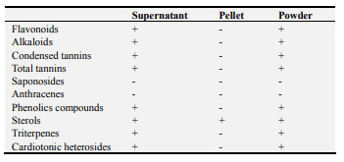
Antioxidant test results that occurred in this research here include the following test DPPH, FRAP, and Anti-inflammatory test, and an antibacterial test.
Figure 5: Test result of the DPPH test
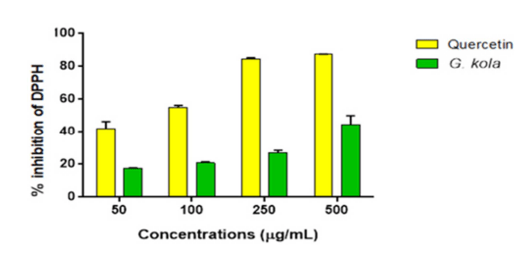
DPPH test help to determine percentage of inhibition of G.kola is supernatant compared to Quercetin. So the G.kola shows a minimum inhibition rate in the DPPH test.
Figure 6: test result of the FRAP test
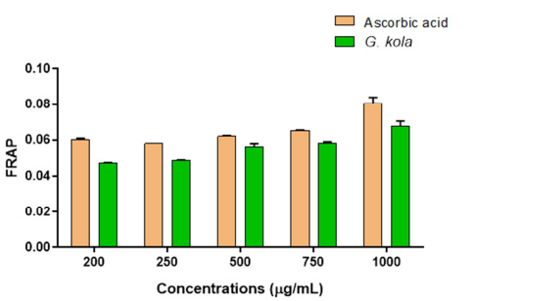
FRAP test determines reducing power of iron is higher in the ascorbic acid rather than G.kola.
Anti-inflammatory test results determine the inhibition rate of G. kola is higher than the other references.
Figure 7: Anti-inflammatory test result

From the sensitivity test, the researcher will understand the sensitivity of G.Kola which is 26 mm. And from MIC and MBC test provide the data of antibacterial activity of G.kola that is 3.12 mg/ml and MBC was 12.5 mg/ml.
In the second research paper, these data were collected. The following graph and tables describe the value which is very much relevant for discuss the topic of the research.
Figure 8: Test result of the DPPH test
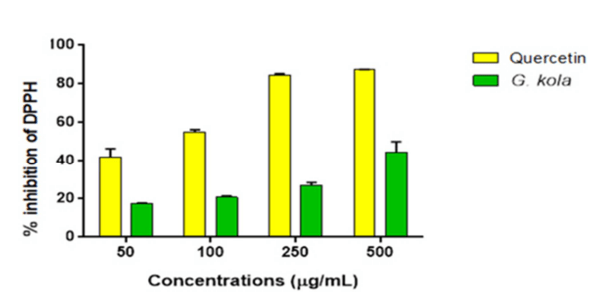
This figure shows the result of DPPH test. For doing this test G. kola and Quercetin are used. The x axis shows the concentration of G Kola and Quercetin and Y -axis shows the percentage of DPPH. To determine the antioxidant activity of G.kola DPPH tests are performed (Arefi, et al, 2018). The result shows that the antioxidant activity of Quercetin is higher than G.kola's antioxidant activity. This result is relevant for knowing the difference of the antioxidant power between G.kola and Quercetin.
Figure 9: test result of the FRAP test
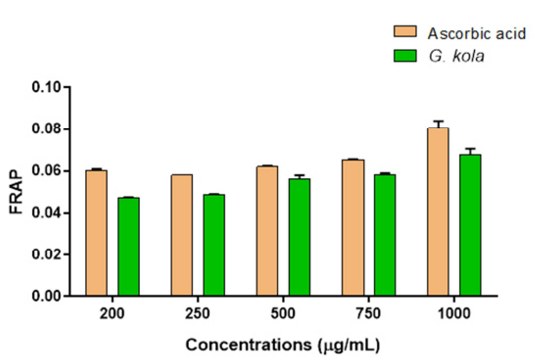
The upper figure shows the antioxidant power of Ascorbic acid and G.kola. The x-axis shows the concentration of G.kola and Ascorbic acid and the Y-axis shows the FRAP value (Comer, 2022). From the figure, it has been shown that the reducing power of iron is higher for ascorbic acid and ascorbic acid has more antioxidant power than G.kola. This result is relevant for testing the antioxidant power.
Figure 10: phytochemical composition of G.kola seeds
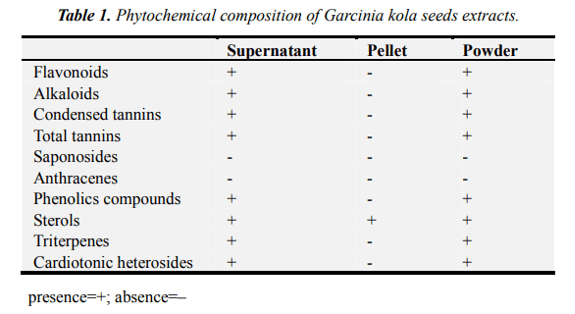
This figure describes the phytochemical screening test of Garcinia Kola seeds. From this the researcher gets knowledge about the Phytochemical composition of Garcinia Kola.
Figure 11: Anti-inflammatory test result
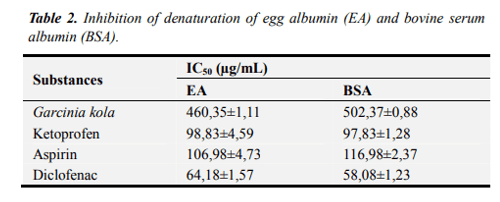
The upper figure shows the anti-inflammatory test result of G.kola. For doing this test Aspirin, diclofenac, and ketoprofen were used. The test result shows that anti-inflammatory activity is higher in G.kola rather than in other substances. This result is very relevant for this research to know the anti-inflammation rate of G.kola.
Figure 12: sensitivity test for the antibacterial test

The upper figure shows that the antibacterial test. Here sensitivity test was occurred. For doing this test G.kola, Amoxicillin, chloraphenicol and tetracycline were used (Kalateh Sadati, et al, 2022). The result shows that S.aureus shows zone of inhibition and the rate of zone of inhibition was 26 mm.
Figure 13: MIC and MBC test

The upper figure shows that minimum inhibitory concentration (MIC) and minimum bacterial concentration (MBC) of G.kola. The MIC value of G.kola was 3.12 mg/mL. The MBC value of G.kola is 12.5 mg/mL for S. aureus. This test result is very relevant from this test result the bresaercher get the idea about MIC and MBC value of G.kola.
From the first research these two tables are found which are relevant to the research.
Figure 14: Zone of inhibition test

Upper figure shows the zone of inhibition rate of the microbial organism ( E.coli, S.aureus, K.pneumoniae, and C.albicans). For detecting the zone of inhibition of the microbial organism Garcinia kola methanolic and aqueous leaf extacr were used. It has been shown that zone of inhibition rate of microbial organism were higher in the Garcinia kola methanolic rather than aqueous leaf extract.
Figure 15: zone of inhibition test

The upper figure shows that zone of inhibition rate of the microbial organism against Chrysophyllum albidum methanolic extract and aqueous leaf extract. The zone of inhibition rate is higher in Chrysophyllum albidum methanolic extract rather than aqueous leaf extract. From this research study, the researcher knows the effective zone of inhibition.
Figure 16: In vitro antimicrobial activity test

The upper figure shows that minimum inhibitory concentration of the microbial organism against Chrysophyllum albidum leaf and Garcinia kola leaf. From this test researchers get knowledge about the invitro antimicrobial activity of Garcinia kola leaf.
After critically discussing these two research it has been known that the first research discusses the in-vitro antimicrobial activity of aqueous leaf and methanolic leaf extract. For doing this research disc diffusion test occurred, in this research antibacterial screening test and an antifungal screening test occurred (Guan, 2019). After doing the research the researcher gets the zone of inhibition rate of the microbial organism against two specimens and the invitro antimicrobial activity of the specimens. This research revealed that aqueous and methanolic leaf extract of Garcinia kola and chrysophylum possess potential microbial activity against clinical isolates. This research discovers the medicine that is found in these leaves for treating the disease.
The second research study help to demonstrate the antioxidant, antimicrobial, and anti-inflammatory activity of Garcinia kola seeds. From this research, the researchers get an idea of the phytochemical composition of G.kola, and this research help to justify the anti-inflammatory, antioxidant and anti-microbial properties. From this research, it gets knowledge about traditional medicine and the alternative source of drugs for treating throat infections.
Reference list
Journals
Introduction to International Healthcare Policy Assignment Every nation has certain healthcare policies to support the...View and Download
Chapter 1: Technical-Functional Specification Assignment 1.1 System Architecture and Technology Stack The e-commerce platform...View and Download
Introduction Get free samples written by our Top-Notch subject experts for taking online Assignment...View and Download
Finance For Strategic Managers Assignment Sample Introduction: Finance For Strategic Managers Assignment Sample Get free...View and Download
Introduction to Data Management Fundamentals Assignment The safest way to handle data these days is my managing them and...View and Download
Introduction to Finance For Strategic Leaders Assignment Finance functions refer to all the activities and practices undertaken...View and Download
